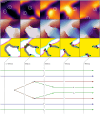Analysis of complex excitation patterns using Feynman-like diagrams
- PMID: 39578507
- PMCID: PMC11584638
- DOI: 10.1038/s41598-024-73544-z
Analysis of complex excitation patterns using Feynman-like diagrams
Abstract
Many extended chemical and biological systems self-organise into complex patterns that drive the medium behaviour in a non-linear fashion. An important class of such systems are excitable media, including neural and cardiac tissues. In extended excitable media, wave breaks can form rotating patterns and turbulence. However, the onset, sustaining and elimination of such complex patterns is currently incompletely understood. The classical theory of phase singularities in excitable media was recently challenged, as extended lines of conduction block were identified as phase discontinuities. Here, we provide a theoretical framework that captures the rich dynamics in excitable systems in terms of three quasiparticles: heads, tails, and pivots. We propose to call these quasiparticles 'cardions'. In simulations and experiments, we show that these basic building blocks combine into at least four different bound states. By representing their interactions similarly to Feynman diagrams in physics, the creation and annihilation of vortex pairs are shown to be sequences of dynamical creation, annihilation, and recombination of the identified quasiparticles. We draw such diagrams for numerical simulations, as well as optical voltage mapping experiments performed on cultured human atrial myocytes (hiAMs). Our results provide a new, unified language for a more detailed theory, analysis, and mechanistic insights of dynamical transitions in excitation patterns.
© 2024. The Author(s).
Conflict of interest statement
Competing interests: The authors declare no competing interests.
Figures









Similar articles
-
Patterns of phase-dependent spiral wave attenuation in excitable media.Phys Rev E Stat Nonlin Soft Matter Phys. 2007 May;75(5 Pt 1):051923. doi: 10.1103/PhysRevE.75.051923. Epub 2007 May 30. Phys Rev E Stat Nonlin Soft Matter Phys. 2007. PMID: 17677114
-
Fast creation of data-driven low-order predictive cardiac tissue excitation models from recorded activation patterns.Comput Biol Med. 2024 Feb;169:107949. doi: 10.1016/j.compbiomed.2024.107949. Epub 2024 Jan 3. Comput Biol Med. 2024. PMID: 38199206
-
Electroelastic unpinning of rotating vortices in biological excitable media.Phys Rev E Stat Nonlin Soft Matter Phys. 2012 Mar;85(3 Pt 1):031915. doi: 10.1103/PhysRevE.85.031915. Epub 2012 Mar 28. Phys Rev E Stat Nonlin Soft Matter Phys. 2012. PMID: 22587131
-
Macroscopic optical mapping of excitation in cardiac cell networks with ultra-high spatiotemporal resolution.Prog Biophys Mol Biol. 2006 Oct;92(2):232-57. doi: 10.1016/j.pbiomolbio.2005.10.003. Epub 2005 Nov 21. Prog Biophys Mol Biol. 2006. PMID: 16330086 Review.
-
Controlling excitable wave behaviors through the tuning of three parameters.Biol Cybern. 2019 Apr;113(1-2):61-70. doi: 10.1007/s00422-018-0771-0. Epub 2018 Jul 28. Biol Cybern. 2019. PMID: 30056608 Review.
References
-
- Lechleiter, J., Girard, S., Peralta, E. & Clapham, D. Spiral calcium wave propagation and annihilation in xenopus laevis oocytes. Science252, 123–126. 10.1126/science.2011747 (1991). - PubMed
-
- Rotermund, H.-H., Engel, W., Kordesch, M. & Ertl, G. Imaging of spatio-temporal pattern evolution during carbon monoxide oxidation on platinum. Nature343, 355–357. 10.1038/343355a0 (1990).
-
- Kapral, R. & Showalter, R. Chemical Waves and Patterns (Kluwer, 1995).
MeSH terms
Grants and funding
LinkOut - more resources
Full Text Sources
Miscellaneous

